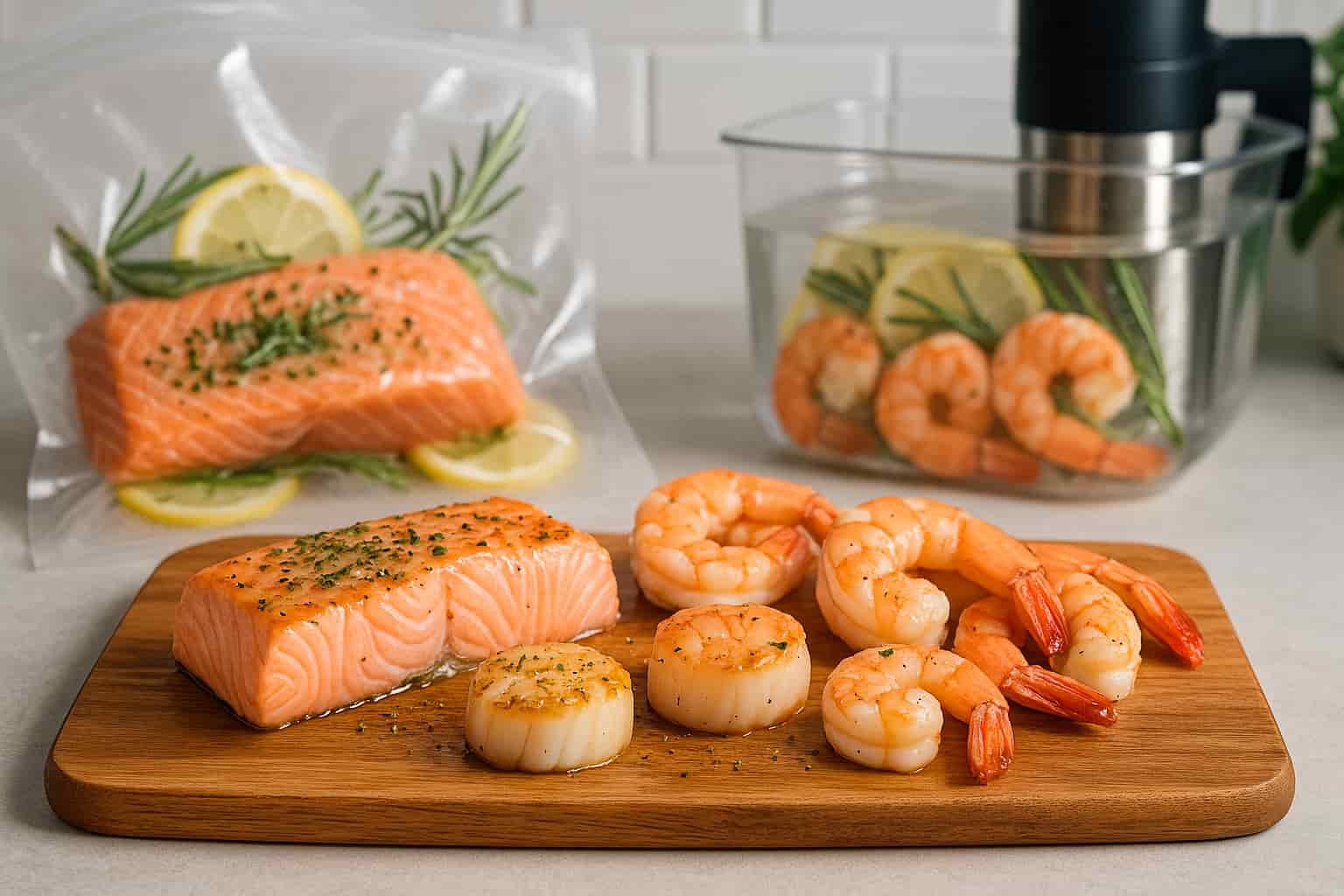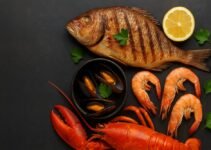Sous vide, a French term meaning “under vacuum,” is a cooking technique that involves sealing food in airtight bags and immersing it in a water bath at a precisely controlled temperature. This method has gained widespread popularity among professional chefs and home cooks alike, thanks to its ability to deliver consistent and precise results.
When it comes to seafood, sous vide offers unique advantages. Delicate proteins like fish, shrimp, and scallops are notoriously easy to overcook using traditional methods. Sous vide eliminates that risk by allowing you to cook seafood at the exact temperature where it becomes perfectly tender and flavorful—without going a degree too far.
In this article, we’ll explore the key benefits of cooking seafood sous vide, recommended temperature and timing guidelines for different types of seafood, and best practices to help you succeed in your kitchen.
Contents
- 1 Benefits of Cooking Seafood Sous Vide
- 2 Best Seafood Types to Cook Sous Vide
- 3 Recommended Temperature and Time Chart for Sous Vide Seafood
- 4 Step-by-Step Guide to Cooking Sous Vide Seafood
- 5 Pro Tips and Common Mistakes to Avoid
- 6 Recipe Ideas and Serving Suggestions with Sous Vide Seafood
- 7 Final Thoughts: Why You Should Try Sous Vide for Seafood
- 8 Bonus Tip: Pair Sous Vide Seafood with Vegetables for Meal Prep
Benefits of Cooking Seafood Sous Vide
Sous vide cooking transforms the way we prepare seafood by offering a level of control and consistency that traditional methods can’t match. Here are some of the standout benefits:
- Perfect Texture Every Time: Seafood cooked sous vide is never rubbery or dry. Because it’s cooked at a low, controlled temperature, the natural tenderness and moisture are preserved, resulting in buttery, melt-in-your-mouth texture.
- Intensified Flavor: Since the seafood is sealed in a bag during cooking, its natural juices, seasonings, and any added aromatics remain locked in. This amplifies the flavor without the need for heavy sauces or fats.
- Nutrient Retention: Sous vide is a gentle cooking method that helps preserve more nutrients than traditional high-heat techniques. There’s less oxidation and no direct contact with water that could leach vitamins and minerals.
- Fail-Proof Cooking: Once you set the desired temperature, there’s minimal risk of overcooking. This is especially helpful for beginners or anyone looking to cook seafood confidently.
Best Seafood Types to Cook Sous Vide
Sous vide is incredibly versatile and works well with a wide variety of seafood. Here are some of the best types to try:
- Fish (Salmon, Cod, Halibut): These fish benefit from sous vide’s precise temperature control, yielding moist, flaky results. For example, salmon cooked sous vide maintains its deep pink color and melts in your mouth.
- Shrimp: Shrimp can quickly become rubbery when pan-fried or boiled, but sous vide keeps them tender and juicy while locking in their sweet, briny flavor.
- Scallops: Delicate and luxurious, scallops are ideal candidates for sous vide. The technique ensures they’re cooked evenly all the way through, making them perfect for a light sear afterward.
- Optional: Octopus and Squid: While more advanced, sous vide is an excellent way to tenderize tougher seafood like octopus or squid, typically requiring longer cook times at higher temperatures.
👉 Curious if scallops can be safely enjoyed raw? Read more in our guide: Can You Eat Scallops Raw? Safety, Taste & How to Enjoy Them
Recommended Temperature and Time Chart for Sous Vide Seafood
Getting the temperature and timing right is essential for achieving perfectly cooked seafood with sous vide. Too low, and the protein may remain undercooked; too high, and you risk ruining its delicate texture. Here’s a practical chart that outlines ideal sous vide temperatures and cooking times for common types of seafood:
| Seafood Type | Temperature (°C) | Temperature (°F) | Cooking Time |
|---|---|---|---|
| Salmon | 50–54°C | 122–129°F | 30–45 minutes |
| Cod | 52°C | 125°F | 30–40 minutes |
| Shrimp | 55°C | 131°F | 20–30 minutes |
| Scallops | 52–54°C | 125–129°F | 30–40 minutes |
| Octopus | 77–85°C | 170–185°F | 4–6 hours |
| Squid | 60–65°C | 140–149°F | 45–60 minutes |
📝 Pro Tip: Always let your seafood come to near-room temperature before sealing and cooking. This ensures more even results.
Step-by-Step Guide to Cooking Sous Vide Seafood
- Choose Fresh, High-Quality Seafood
Start with the freshest ingredients possible. Look for firm flesh, clear eyes (for whole fish), and a clean smell—never fishy or sour. - Season Lightly and Seal Properly
Season with salt, herbs, citrus slices, or a small amount of olive oil. Use a vacuum sealer or the water displacement method to remove air from the bag. - Preheat Your Water Bath
Set your sous vide immersion circulator to the desired temperature based on the type of seafood. Wait until the water reaches that exact temperature before adding your bagged seafood. - Submerge and Cook
Clip the bag to the side of the container, ensuring it’s fully submerged. Cook for the time recommended in the temperature chart above. - Finish (Optional)
While seafood is fully cooked after sous vide, a quick sear in a hot pan can add flavor and a golden crust—especially for fish or scallops.
Pro Tips and Common Mistakes to Avoid
- Don’t Overcrowd the Bag: Give each piece of seafood room in the vacuum bag to ensure even cooking. Avoid stacking shrimp or fish fillets.
- Avoid Overseasoning: Since flavors intensify in a sealed bag, go easy on salt, garlic, or acidic ingredients like lemon. You can always add more after cooking.
- Use Food-Safe Bags: Only use BPA-free, food-grade plastic bags or vacuum pouches. Never use regular zip-lock bags unless they’re labeled as safe for sous vide.
- Double-Check Seals: A leaky bag can ruin your results. Ensure the seal is tight, and no water can seep into the bag during cooking.
- Dry Before Searing: If you’re searing the seafood post-sous vide, pat it completely dry with paper towels first. Moisture can prevent browning and cause oil to splatter.
Recipe Ideas and Serving Suggestions with Sous Vide Seafood
Once your seafood is perfectly cooked sous vide, the possibilities for plating and pairing are endless. Here are a few delicious and practical ideas:
- Sous Vide Salmon with Lemon Butter Sauce
After sous vide cooking, sear the salmon briefly in a hot pan and serve it with a lemon butter and caper sauce. Pair it with roasted asparagus or a quinoa salad. - Garlic Herb Sous Vide Shrimp for Salads or Pasta
Cook shrimp sous vide with garlic, olive oil, and herbs. Once done, toss them with linguine and cherry tomatoes, or chill and serve on top of a Mediterranean salad. - Sous Vide Scallops over Creamy Risotto
Scallops benefit from a quick sear after sous vide cooking. Serve them over a creamy mushroom or lemon risotto for an elegant yet easy dinner. - Taco Night with Sous Vide Fish
Use flaky white fish like cod or halibut, season with cumin and lime before sealing, and serve in tortillas with avocado slaw and chipotle crema.
These recipes showcase the versatility of sous vide seafood, whether you’re cooking for a casual lunch or a gourmet dinner.
Final Thoughts: Why You Should Try Sous Vide for Seafood
Cooking seafood can be intimidating, even for seasoned home cooks. With sous vide, you remove much of the guesswork and achieve restaurant-quality results every time. Whether you’re cooking delicate salmon, sweet shrimp, or rich scallops, this technique helps you lock in flavor, retain nutrients, and create perfectly cooked dishes with ease.
The precise temperature control and flexibility of sous vide also mean fewer mistakes, less stress, and more time to enjoy the process. Once you experience the texture and taste difference, you might never go back to boiling, baking, or pan-searing seafood the traditional way.
Bonus Tip: Pair Sous Vide Seafood with Vegetables for Meal Prep
If you’re into batch cooking or healthy meal prep, sous vide can help you prepare multiple components at once. Try pairing your sous vide seafood with:
- Sous vide asparagus or green beans
- Roasted sweet potatoes or carrots (finished in oven)
- Brown rice, couscous, or quinoa
This approach allows you to build balanced, flavorful meals with minimal fuss—perfect for lunchboxes, weeknight dinners, or entertaining guests.



